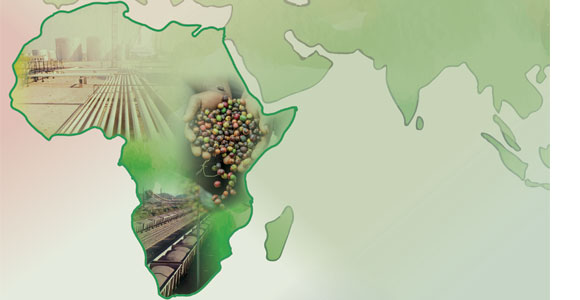A Competitive Africa
Economic integration could make the continent a global player

Africa ranks near the bottom when it comes to competing in the global economy, held back by fragmented markets that inhibit efficiency and constrain economic growth.
Now a new player is emerging with the potential to defragment Africa and boost the productivity of its economies: the African Continental Free Trade Area (AfCFTA). In March 2018, 44 African heads of state signed a framework to establish a single continental market for goods and services, with free movement of capital and business travelers. Five additional countries, including South Africa, joined in July. The AfCFTA still needs ratification by the parliaments of at least 22 countries; seven have done so thus far.
In addition to increasing market efficiency and reducing the cost of doing business by offering opportunities for economies of scale, the AfCFTA could ease trade and investment flows and shift the composition and direction of foreign direct investment flows into Africa.
The big question is whether this effort will also elevate the competitiveness of African economies. Competitiveness—the set of institutions, policies, and factors driving productivity—is a key determinant of sustainable growth and provides a path for effective integration into the global economy.
The Global Competitiveness Index, a performance indicator generated every year by the World Economic Forum to benchmark countries, shows large variations in national competitiveness rankings. These have to do with the stage of economic development, the gap in physical and technological infrastructure between developed and many developing economies, and the inability of a number of developing economies to undertake the critical economic and institutional reforms needed to raise their market efficiency.
The few African countries that have emerged as the fastest-growing economies in the past decade have also been on an upward trajectory on the global competitiveness ladder. Increasingly, these countries (most notably Côte d’Ivoire, Ethiopia, and Rwanda) are drawing on their improving competitiveness and macroeconomic environment to diversify their sources of growth and trade and, in the process, expand their share of the global market pie. However, most African countries are probably latecomers in the race to boost competitiveness. Lately, the global economic environment has been dominated by the rise of beggar-thy-neighbor nationalism and creeping protectionism. Leading economies are moving away from the rules-based system that has governed global trading arrangements for decades toward a new mercantilist system that measures a country’s economic performance by its trade surplus.
In this new reality, competitiveness is perhaps even more important for
emerging market and developing economies. In Africa, the push to deepen
economic integration and boost intra-
African trade under the AfCFTA is also likely to mitigate the costs of
adverse global shocks. A larger effective domestic market acts as insurance
against disruptions to global trade associated either with global
volatility or with contraction in global demand.
Active versus passive globalizers
In a zero-sum trading landscape, more and more countries are vying for the same market. Only the most competitive—those with strong economic fundamentals and policy frameworks and diversified sources of growth—are likely to expand and sustain the growth of their share of global trade. These "active globalizers" are arguably the best positioned to mitigate the risks associated with global economic and financial integration and therefore to take full advantage of the benefits of globalization. The least competitive economies have been "passive globalizers," or impotent victims of globalization that have consistently acted as feedstock, supplying the raw materials and natural resources required to expand manufacturing output in more actively globalizing nations (Fofack, forthcoming).
Not surprisingly, passive globalizers have been more vulnerable to the risks of globalization. These include faster global transmission of negative shocks, swings in commodity prices, long-term deterioration in the commodity terms of trade, and lower global demand triggered by either creeping protectionism or synchronized downturns. These risks have stifled the aspirations of lagging nations, most of which have found themselves locked into vicious cycles of excess growth volatility and structural balance-of-payments crises. This perhaps suggests wide-ranging macroeconomic implications of competitiveness.
Competitiveness goes hand in hand with trade performance, and therefore with economic growth. And the largest single determinant of GDP growth in both developed and developing economies is innovation. Africa’s fastest-growing economies are also making the greatest strides toward diversification of exports. The degree of innovation and efficiency in production processes may well be the fault line between developed and developing economies, as well as between active and passive globalizers.
Africa faces a host of hurdles to competitiveness and trade. Steps to improve the economic infrastructure and reforms to boost innovation have been stifled by institutional resistance and heavy costs associated with infrastructure development and technological catch-up. Progress has been equally slow on efficiency-driven competitiveness factors—technological readiness, market size, and efficiency of goods and labor markets. In addition, market fragmentation has held back growth by discouraging large-scale and long-term investment.
Despite lower import duty within the continent’s various regional economic communities, a range of nontariff and regulatory barriers continues to raise transaction costs and limit the movement of goods, services, labor, and capital across borders. These barriers include border delays, burdensome customs and inspection procedures, multiple licensing requirements, and increasingly the requirement that importers secure national transit bonds along key routes. Trading across borders in Africa is still more costly and time-consuming than in any other region of the world—and African countries trade more with the rest of the world than with each other.
The average cost of importing a container in Africa is about $2,492 compared with $935 in East Asia and the Pacific and $1,488 in Latin America and the Caribbean (Brenton and Isik 2012). Not surprisingly, intraregional trade, though on the rise, is still relatively rare, accounting for only about 15 percent of total African trade, compared with 68 percent in Europe and 58 percent in Asia (Fofack, forthcoming; Afreximbank 2018). In addition to nontariff barriers, the state of governance, the structure of production, the direction of trade inherited from the colonial model of resource extraction, and supply-side constraints are at play. Supply-side constraints include a low manufacturing base, costly trade financing, limited access to information, and trade-enabling infrastructure that is either lacking or costly.
The process of defragmenting Africa under the AfCFTA is therefore the first step toward boosting competitiveness and integrating African economies into the global economy as active globalizers. The continental free trade area will establish a market of 1.2 billion people with a combined GDP of $2.5 trillion and combined consumer and business spending of more than $4 trillion. Basic simulations that assume expanded and increased efficiency of goods and labor markets under the AfCFTA point to a significant increase in Africa’s overall ranking on the Global Competitiveness Index in both the short and the medium term.
Over the long term, the average ranking for Africa could rise even further. This could happen if the continental free trade area begets a more dynamic trade and economic environment that expands manufacturing bases, sustains the growth of agro-processing industries fit for value chain integration, and accelerates the development and integration of financial markets. Such financial progress could, for instance, enable cross-listing of firms in different stock markets and promote the development of nonbank financing and the establishment of credit reference bureaus to reduce information asymmetry and credit risk. Ultimately, these measures could ease access to credit in a region where more shallow financial intermediation and fragmented financial markets have put the kibosh on competitiveness and private sector growth.
Establishing one of the largest free trade areas in the world could boost competitiveness through other channels as well: technology transfer, industrial development, diversification of sources of growth, and expansion of intra-African trade. A recent review of the African competitiveness landscape blames limited progress in these areas for stalled productivity growth and competitiveness and singles out relatively low regional trade and integration as a major bottleneck (WEF 2017). The same review also highlights overlapping regional economic communities as a major constraint to the kind of business-friendly environment entrepreneurs need to take advantage of growth opportunities.
Preliminary estimates of the expected benefits of the AfCFTA, in terms of trade performance and regional integration, are positive and significant. The United Nations Economic Commission for Africa estimates that intra-African trade, largely dominated by industrial products and manufactured goods, could increase by more than 50 percent and even double about a decade into the implementation of the AfCFTA, if the envisioned reforms are fully carried out and complemented by robust trade facilitation measures.
The requirement that participating countries remove tariffs on at least 90 percent of goods would drive this increase. Economies of scale as a result of a larger continental market could lower overall production costs, which remain very high; stimulate cross-border trade and investment within Africa; and attract additional foreign direct investment to the region while also shifting it toward the production of industrial and manufactured goods. This would boost intraregional trade in intermediate and capital goods. Attendant benefits include technology transfer and development of regional value chains in which African businesses add value as they turn raw materials into finished goods.
"Factory Africa"
These regional value chains could help integrate African economies into the global economy, whose manufacturing processes are driven increasingly by the globalization of supply and value chains. Despite the rise in outsourcing production to several countries, much of the value-added distribution in global value chains remains within regional blocs. Hence the increasing references to "Factory Europe," "Factory North America," and "Factory Asia"—the continents where these value chains are concentrated (Stöllinger and others 2018). The rise of value chains in regional blocs and their continued relevance in the face of entrenched globalization reflect their many inherent benefits, most notably lower transit costs and shorter supply chains associated with either sourcing or manufacturing closer to target export markets.
The AfCFTA could eventually give birth to "Factory Africa." In time, the
emergence of
"Factory Africa"—and ultimately, the connection of Africa-based factories
and production chains to global value chains—would link production networks
from all continents.
For decades, Africa has been labeled as a continent full of potential—yet year after year, realizing this potential has been one of its main challenges. If the AfCFTA succeeds in inspiring these reforms, the new free trade area could unleash forces for African dynamism and position the continent as a global competitor.
PHOTO: ISTOCK/WANGANQI. ALAMY/ ANDREY GUDKOV, ALAMY/ BARRY IVERSON, ALAMY/ PETE TITMUSS
Opinions expressed in articles and other materials are those of the authors; they do not necessarily reflect IMF policy.
References:
Brenton, Paul, and Gözde Isik, eds. 2012. "De-Fragmenting Africa: Deepening Regional Trade Integration in Goods and Services." World Bank, Washington, DC.
Fofack, Hippolyte. Forthcoming. "Leveraging the African Private Sector to Enhance the Development Impact of the African Continental Free Trade Area Agreement." World Economics Journal, December 2018.
Stöllinger Roman, Doris Hanzl-Weiss, Sandra Leitner, and Robert Stehrer. 2018. "Global and Regional Value Chains: How Important, How Different?" WIIW Research Report 427. Vienna Institute for International Economic Studies, Vienna.
World Economic Forum (WEF). 2017. "https://www.weforum.org/reports/africa-competitiveness-report-2017The Africa Competitiveness Report 2017." World Economic Forum, Geneva.







